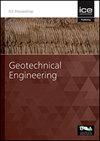Post-Construction Safety Assessment of a High Concrete Face Rockfill Dam
IF 1.7
4区 工程技术
Q3 ENGINEERING, GEOLOGICAL
Proceedings of the Institution of Civil Engineers-Geotechnical Engineering
Pub Date : 2022-05-30
DOI:10.1680/jgeen.21.00167
引用次数: 0
Abstract
The most important issue regarding the safety and performance of concrete face rockfill dams (CFRDs) is to determine stresses and deformations. However, predictions of crest settlements of concrete face rockfill dams (CFRDs) are usually performed by using empirical relationships. Since, in recent years, CFRDs are constructed much higher and more complicated topographical and geological dam sites, these require performing numerical analysis to evaluate the stress and deformations in the entire dam body. Numerical estimation of deformations and crest settlements is also crucial particularly to determine parapet wall heights and freeboard allowances at the design stage. In addition, assessing long-term rockfill behavior and the concrete face membrane crack potential are important for post construction dam safety. The objective of this study is to evaluate post-construction deformations and crest settlements of a high concrete faced rockfill dam under two different loading cases considering nonlinear elasto- plastic behavior of the rockfill structure. As constitutive model, Duncan-Chang hyperbolic stress-strain model was applied in finite element simulations considering the failure criterion is isotropic and hardening. Calibration of the rockfill's hyperbolic parameters was performed by comparing the calculated displacements with the actual settlement measurements from the instruments. Computed crest settlements were also compared with those of some CFRDs given in the literature. Calculated crest settlement and other deformations were in good agreement with the rockfill settlement measurements and in acceptable ranges, and do not threat the dam's safety.某高面板堆石坝施工后安全评价
面板堆石坝的应力和变形的确定是影响面板堆石坝安全性能的关键问题。然而,混凝土面板堆石坝(cfrd)坝顶沉降的预测通常采用经验关系进行。近年来,由于cfrd的建设高度和地形、地质条件都大大提高,因此需要对整个坝体的应力和变形进行数值分析。变形和波顶沉降的数值估计也至关重要,特别是在设计阶段确定胸墙高度和干舷余量。此外,评估堆石层的长期性能和混凝土面膜裂缝电位对坝后安全具有重要意义。考虑堆石坝结构的非线性弹塑性特性,对高面板堆石坝在两种不同荷载作用下的施工后变形和坝顶沉降进行了研究。考虑各向同性和硬化破坏准则,采用Duncan-Chang双曲应力-应变模型作为本构模型进行有限元模拟。通过将计算的位移与仪器的实际沉降测量值进行比较,对堆石料的双曲参数进行了校准。计算的峰值沉降也与文献中给出的一些cfrd的计算结果进行了比较。计算的坝顶沉降及其他变形与堆石料沉降测量值吻合较好,在可接受的范围内,对大坝安全没有威胁。
本文章由计算机程序翻译,如有差异,请以英文原文为准。
求助全文
约1分钟内获得全文
求助全文
来源期刊
CiteScore
4.40
自引率
4.50%
发文量
68
审稿时长
3 months
期刊介绍:
Geotechnical Engineering provides a forum for the publication of high quality, topical and relevant technical papers covering all aspects of geotechnical research, design, construction and performance. The journal aims to be of interest to those civil, structural or geotechnical engineering practitioners wishing to develop a greater understanding of the influence of geotechnics on the built environment.

 求助内容:
求助内容: 应助结果提醒方式:
应助结果提醒方式:


